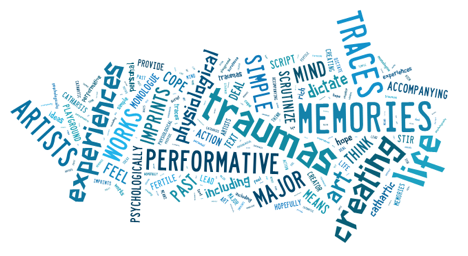Trauma and Memory: Healing Through Art
Keywords:
psychology, healing and art, simple trauma, memory, performance art, visual art, art educationAbstract
Life’s traumas, whether major or simple traumas, create traces in the mind. These trauma traces, as physiological imprints or memories of past experiences, often dictate how we think, feel, and cope with life. Artists, including performance artists, often scrutinize memory and trauma as a means to psychologically deal with those experiences in their art and life. Their works are often cathartic, as in the accompanying script for a performative action monologue. With this text I hope to stir personal memories and provide a fertile playground for ideas that lead to creating rich works of art, hopefully with some catharsis for the creator.
References
References
American Psychological Association. (1995, August). Questions and answers about memories of childhood abuse [Data file]. Washington, DC. Retrieved from http://www.apa.org/topics/trauma/memories.aspx
Author. (1999). Embracing a critical pedagogy in art education. Art Education, 52(5), 18-24.
Author. (2001). If an artwork could speak, what would it say? Focusing on issues for elementary art education. In Y. Gaudelius & P. Spears. (Eds.), Contemporary Issues in Art Education. Englewood Cliffs, NJ: Prentice Hall.
Art21: Art in the Twenty-First Century. (2009). William Kentridge, Compassion. Retrieved from http://www.art21.org/artists/william-kentridge
Art21: Art in the Twenty-First Century. (2008). William Kentridge. Meaning. Retrieved from http://www.art21.og/films/exclusive
Bloom, S. L. (1996). Bridging the black hole of trauma: Victims, artists and society. Retrieved from http://www.nonviolenceandsocialjustice.org/Research-Literature/Sanctuary-Model-literature-and-works-by-Sandra-Bloom/Bridging-the-Black-Hole-of-Trauma-Victims-Artists-and-Society/77/
Bloom, S. L. (October, 1999). Trauma theory abbreviated. Final Action Plan: A Coordinated Community-Based Response to Family Violence. Attorney General of Pennsylvania’s Family Violence Task Force. Retrieved from http://www.dhs.vic.gov.au/__data/assets/pdf_file/0005/587966/trauma_theory_abbreviated_sandra_bloom.pdf
Borkovec, T. (1996, October). Cognitive behavioral treatment for generalized anxiety disorders. Paper presented at The Performance Art, Culture, Pedagogy Symposium, The Pennsylvania State University, University Park, PA.
Dika, V. (1988, January). Swimming to Cambodia. Art in America [Film review], 76, 37+.
Freud, S., Strahey, J., Breuer, J., Richards, A. (2001). The Standard Edition of the Complete Works of Sigmund Freud. London, England: Vintage.
Gomez-Pena, G. (2003). In defense of performance art: A foremost practitioner explains his métier. Art Papers, 27, 22-27. Retrieved from http://www.pochanostra.com/antes/jazz_pocha2/mainpages/in_defense.htm
Green, G. L. (1999). The return of the body: Performance art and art education. Art Education, 52(1), 6-12.
Hirigoyen, M. F. (2005). Stalking the soul: Emotional abuse and the erosion of identity. New York, NY: Turtle Point Press.
Jacobs, S., Mazure,C., & Prigerson, H. (2000). Diagnostic criteria for traumatic grief. Death Studies, 24, 185–199.
Kartofel, G. (2005). Don’t call it performance. Art Nexus, 3(56), 170-172.
McKim, R. (1987). Swimming to Cambodia [Film Review].Cinéaste, 41-43.
Nader, (2010). Traumatic grief [Data File]. The International Society for Traumatic Stress Studies. Retrieved from http://www.istss.org/source/search/index.cfm?q=tramatic+loss+and+traumatic+grief&i_Search=GO
Nunn, H. (2004). Errol Morris: Documentary as psychic drama. Screen, 45(4), 413-422.
Perry, B. D. (2000). Traumatized children: How childhood trauma influences brain development. The Journal of the California Alliance for the Mentally Ill, 11(1), 48-51. Retrieved from http://www.aaets.org/article196.htm
Pollock, G. (1999). Old bones and cocktail dresses: Louise Bourgeois and the question of age. Oxford Art Journal, 22(2), 71-100.
Salmon, R. (2000). Through the looking glass: Feminine self-image in art. Sculpture Review, 49(3), 20-23.
The International Society for Traumatic Stress Studies. (2005). Traumatic loss and traumatic grief [Data file]. Retrieved from http://www.istss.org/terrorism/sudden_traumatic_loss.htm
Van der Kolk, B., McFarlane, A. C., Waisaeth, L. (Eds.). (1996/2007). Traumatic stress: The effects of overwhelming experience on mind, body, and society. New York, NY: Guilford Press.
Wolfe, B. (2003). Grief counseling and therapy. In R. Kastenbaum (Ed.), Macmillan Encyclopedia of Death and Dying, 1, New York, NY: Macmillan Reference USA. 389-393. Retrieved from http://www.gale.com/servlet/ItemDetailServlet?region=9&imprint=000&titleCode=M189&cf=e&type=4&id =189931

Published
Issue
Section
License
Authors who publish with this journal agree to the following terms:- Authors retain copyright and grant the journal right of first publication with the work simultaneously licensed under a Creative Commons Attribution License that allows others to share the work with an acknowledgement of the work's authorship and initial publication in this journal.
- Authors are able to enter into separate, additional contractual arrangements for the non-exclusive distribution of the journal's published version of the work (e.g., post it to an institutional repository or publish it in a book), with an acknowledgement of its initial publication in this journal.
- Authors are permitted and encouraged to post their work online (e.g., in institutional repositories or on their website) prior to and during the submission process, as it can lead to productive exchanges, as well as earlier and greater citation of published work (See The Effect of Open Access).

